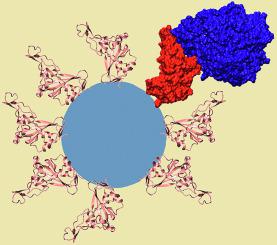Current Opinion in Colloid & Interface Science ( IF 7.9 ) Pub Date : 2021-04-23 , DOI: 10.1016/j.cocis.2021.101461 Mohammed A H Farouq 1 , Mohammed M Al Qaraghuli 1 , Karina Kubiak-Ossowska 2 , Valerie A Ferro 3 , Paul A Mulheran 1

|
Nanoparticles are small particles sized 1–100 nm, which have a large surface-to-volume ratio, allowing efficient adsorption of drugs, proteins, and other chemical compounds. Consequently, functionalized nanoparticles have potential diagnostic and therapeutic applications. A variety of nanoparticles have been studied, including those constructed from inorganic materials, biopolymers, and lipids. In this review, we focus on recent work targeting the severe acute respiratory syndrome coronavirus 2 virus that causes coronavirus disease (COVID-19). Understanding the interactions between coronavirus-specific proteins (such as the spike protein and its host cell receptor angiotensin-converting enzyme 2) with different nanoparticles paves the way to the development of new therapeutics and diagnostics that are urgently needed for the fight against COVID-19, and indeed for related future viral threats that may emerge.
中文翻译:

与纳米粒子的生物分子相互作用:2019 冠状病毒病的应用
纳米粒子是尺寸为 1–100 nm 的小粒子,具有较大的表面积与体积比,可以有效吸附药物、蛋白质和其他化合物。因此,功能化的纳米粒子具有潜在的诊断和治疗应用。已经研究了多种纳米粒子,包括那些由无机材料、生物聚合物和脂质构成的纳米粒子。在这篇综述中,我们重点关注最近针对导致冠状病毒病 (COVID-19) 的严重急性呼吸系统综合症冠状病毒 2 病毒的工作。了解冠状病毒特异性蛋白(如刺突蛋白及其宿主细胞受体血管紧张素转换酶 2)与不同纳米粒子之间的相互作用,为开发对抗 COVID-19 迫切需要的新疗法和诊断方法铺平了道路,











































 京公网安备 11010802027423号
京公网安备 11010802027423号